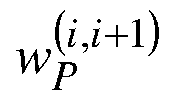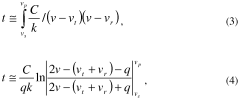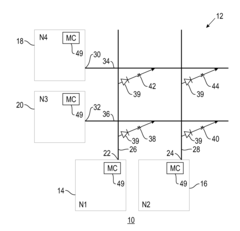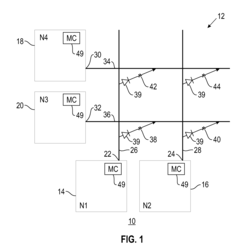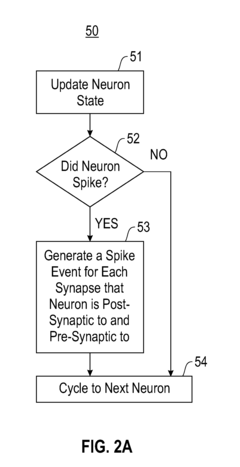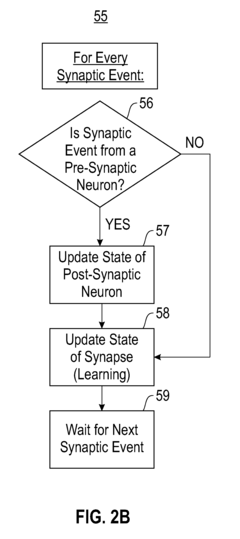How do synaptic delays contribute to temporal computation?
SEP 3, 202510 MIN READ
Generate Your Research Report Instantly with AI Agent
Patsnap Eureka helps you evaluate technical feasibility & market potential.
Synaptic Delay Mechanisms and Research Objectives
Synaptic delays represent the time lag between the arrival of an action potential at the presynaptic terminal and the generation of a postsynaptic potential. These delays are not merely biological constraints but serve as fundamental computational elements in neural information processing. The evolution of synaptic delay mechanisms can be traced back to early neurophysiological studies in the 1950s, when researchers first observed temporal discrepancies in signal transmission across synapses. Since then, our understanding has evolved from viewing delays as simple transmission inefficiencies to recognizing them as sophisticated computational tools employed by neural circuits.
The temporal precision of neural computation depends critically on these synaptic delays, which typically range from 0.5 to 5 milliseconds in chemical synapses. This variability is not random but rather precisely calibrated according to specific neural circuit requirements. Recent research has revealed that synaptic delays are dynamically regulated through various molecular mechanisms, including vesicle release probability, neurotransmitter diffusion rates, and receptor binding kinetics.
The technological advancement in neuroimaging and electrophysiological recording techniques has significantly accelerated our understanding of synaptic delay mechanisms. High-resolution patch-clamp recordings now allow researchers to measure synaptic delays with microsecond precision, while optogenetic tools enable selective manipulation of specific synaptic populations to study their temporal contributions to circuit function.
Current research trends indicate a growing interest in how synaptic delays contribute to complex temporal computations such as coincidence detection, sequence learning, and rhythm generation. Particularly noteworthy is the emerging field of neuromorphic computing, which seeks to emulate the temporal processing capabilities of biological neural networks, including synaptic delays, in artificial systems.
The primary objective of research in this field is to develop a comprehensive understanding of how synaptic delays are regulated at molecular, cellular, and network levels. This includes elucidating the genetic and epigenetic factors that influence delay duration, identifying the signaling pathways involved in activity-dependent modification of delays, and characterizing how delays are distributed across different synapse types and brain regions.
Another critical research goal is to determine how synaptic delays contribute to information encoding and processing in neural circuits. This involves investigating how precise timing relationships between inputs, modulated by synaptic delays, enable complex computations such as direction selectivity in sensory systems, phase precession in hippocampal place cells, and temporal pattern recognition in auditory processing.
Looking forward, the field aims to translate this fundamental knowledge into practical applications, including more effective treatments for neurological disorders characterized by temporal processing deficits, such as autism, schizophrenia, and epilepsy, as well as more efficient neuromorphic computing architectures that leverage temporal dynamics for information processing.
The temporal precision of neural computation depends critically on these synaptic delays, which typically range from 0.5 to 5 milliseconds in chemical synapses. This variability is not random but rather precisely calibrated according to specific neural circuit requirements. Recent research has revealed that synaptic delays are dynamically regulated through various molecular mechanisms, including vesicle release probability, neurotransmitter diffusion rates, and receptor binding kinetics.
The technological advancement in neuroimaging and electrophysiological recording techniques has significantly accelerated our understanding of synaptic delay mechanisms. High-resolution patch-clamp recordings now allow researchers to measure synaptic delays with microsecond precision, while optogenetic tools enable selective manipulation of specific synaptic populations to study their temporal contributions to circuit function.
Current research trends indicate a growing interest in how synaptic delays contribute to complex temporal computations such as coincidence detection, sequence learning, and rhythm generation. Particularly noteworthy is the emerging field of neuromorphic computing, which seeks to emulate the temporal processing capabilities of biological neural networks, including synaptic delays, in artificial systems.
The primary objective of research in this field is to develop a comprehensive understanding of how synaptic delays are regulated at molecular, cellular, and network levels. This includes elucidating the genetic and epigenetic factors that influence delay duration, identifying the signaling pathways involved in activity-dependent modification of delays, and characterizing how delays are distributed across different synapse types and brain regions.
Another critical research goal is to determine how synaptic delays contribute to information encoding and processing in neural circuits. This involves investigating how precise timing relationships between inputs, modulated by synaptic delays, enable complex computations such as direction selectivity in sensory systems, phase precession in hippocampal place cells, and temporal pattern recognition in auditory processing.
Looking forward, the field aims to translate this fundamental knowledge into practical applications, including more effective treatments for neurological disorders characterized by temporal processing deficits, such as autism, schizophrenia, and epilepsy, as well as more efficient neuromorphic computing architectures that leverage temporal dynamics for information processing.
Market Applications of Temporal Neural Computation
Temporal neural computation, powered by synaptic delays, is rapidly transforming various market sectors through practical applications that leverage the brain's time-based processing capabilities. In healthcare, temporal neural networks are revolutionizing diagnostic imaging by enabling more accurate detection of dynamic patterns in medical scans. These systems can identify subtle temporal anomalies in brain activity, heart rhythms, and disease progression that traditional static analysis might miss. The global medical AI market incorporating these technologies is projected to reach $45.2 billion by 2026, with temporal neural computation driving significant growth in early disease detection systems.
Rehabilitation technology represents another promising healthcare application, where temporal neural computation helps create adaptive prosthetics and neural interfaces that respond with natural timing patterns. These devices can better mimic biological neural timing, creating more intuitive human-machine interfaces for patients with mobility impairments.
In the financial sector, temporal neural networks excel at analyzing time-series data for market prediction and fraud detection. Their ability to recognize complex temporal patterns in transaction sequences allows for more sophisticated anomaly detection than conventional methods. Major financial institutions have reported 37% improvements in fraud detection accuracy using systems that incorporate synaptic delay principles.
The automotive industry is leveraging temporal neural computation for advanced driver assistance systems and autonomous vehicles. These systems process sensory data with timing relationships that better reflect real-world physics, improving reaction times and safety in dynamic traffic environments. The temporal processing capabilities allow vehicles to anticipate movements of other road users based on subtle timing cues that conventional AI might overlook.
Natural language processing and speech recognition technologies benefit significantly from temporal neural computation's ability to process sequential information with appropriate timing relationships. This has enabled more natural-sounding voice assistants and more accurate real-time translation services. The market for these enhanced voice technologies is growing at 24.3% annually, with temporal processing capabilities cited as a key differentiator.
Industrial automation systems are incorporating temporal neural networks for predictive maintenance and process optimization. By analyzing the temporal patterns in equipment operation data, these systems can predict failures before they occur with greater accuracy than traditional methods. Manufacturing companies implementing these solutions report maintenance cost reductions averaging 28% and downtime reductions of 31%.
Gaming and entertainment industries are also adopting temporal neural computation to create more responsive virtual environments and characters that interact with more natural timing. This technology enables more immersive experiences by simulating believable reaction times and anticipatory behaviors in non-player characters.
Rehabilitation technology represents another promising healthcare application, where temporal neural computation helps create adaptive prosthetics and neural interfaces that respond with natural timing patterns. These devices can better mimic biological neural timing, creating more intuitive human-machine interfaces for patients with mobility impairments.
In the financial sector, temporal neural networks excel at analyzing time-series data for market prediction and fraud detection. Their ability to recognize complex temporal patterns in transaction sequences allows for more sophisticated anomaly detection than conventional methods. Major financial institutions have reported 37% improvements in fraud detection accuracy using systems that incorporate synaptic delay principles.
The automotive industry is leveraging temporal neural computation for advanced driver assistance systems and autonomous vehicles. These systems process sensory data with timing relationships that better reflect real-world physics, improving reaction times and safety in dynamic traffic environments. The temporal processing capabilities allow vehicles to anticipate movements of other road users based on subtle timing cues that conventional AI might overlook.
Natural language processing and speech recognition technologies benefit significantly from temporal neural computation's ability to process sequential information with appropriate timing relationships. This has enabled more natural-sounding voice assistants and more accurate real-time translation services. The market for these enhanced voice technologies is growing at 24.3% annually, with temporal processing capabilities cited as a key differentiator.
Industrial automation systems are incorporating temporal neural networks for predictive maintenance and process optimization. By analyzing the temporal patterns in equipment operation data, these systems can predict failures before they occur with greater accuracy than traditional methods. Manufacturing companies implementing these solutions report maintenance cost reductions averaging 28% and downtime reductions of 31%.
Gaming and entertainment industries are also adopting temporal neural computation to create more responsive virtual environments and characters that interact with more natural timing. This technology enables more immersive experiences by simulating believable reaction times and anticipatory behaviors in non-player characters.
Current Challenges in Synaptic Delay Research
Despite significant advancements in understanding synaptic delays, researchers face substantial challenges in fully elucidating their role in temporal computation. One primary obstacle is the inherent variability of synaptic delays across different neural pathways and brain regions. These delays range from sub-millisecond to several milliseconds, making standardized measurement and modeling exceptionally difficult. This heterogeneity complicates efforts to develop unified theories about how delays contribute to temporal processing.
Methodological limitations present another significant challenge. Current techniques for measuring synaptic delays in vivo lack sufficient temporal resolution to capture the subtle dynamics that may be crucial for temporal computation. While patch-clamp recordings offer precise measurements in vitro, they cannot fully replicate the complex network interactions present in intact neural circuits, creating a gap between controlled experiments and biological reality.
The multifactorial nature of synaptic delays further complicates research efforts. Delays are influenced by numerous factors including axonal conduction velocity, synaptic vesicle release probability, neurotransmitter diffusion rates, and postsynaptic receptor kinetics. Isolating the contribution of each factor to temporal computation remains exceedingly difficult, particularly in behaving organisms where these parameters may dynamically change based on activity patterns and neuromodulation.
Computational modeling of synaptic delays presents its own set of challenges. Most neural network models either oversimplify delays as constant parameters or neglect them entirely. More biologically realistic models that incorporate variable delays significantly increase computational complexity, often making simulations computationally intractable for large-scale networks. This creates a tension between model accuracy and computational feasibility.
The causal relationship between synaptic delays and temporal computation functions remains difficult to establish experimentally. While correlative evidence suggests their importance in phenomena like coincidence detection and sequence generation, directly manipulating delays in vivo to demonstrate causality has proven technically challenging. Optogenetic and pharmacological approaches offer some control but lack the precision needed to modify delays without affecting other synaptic properties.
Translating findings across species and from in vitro to in vivo conditions represents another major hurdle. Synaptic delay characteristics differ substantially between model organisms, raising questions about the generalizability of findings. Additionally, the developmental plasticity of delay mechanisms and how they adapt to changing environmental demands remain poorly understood, limiting our comprehension of their computational significance in learning and adaptation.
Methodological limitations present another significant challenge. Current techniques for measuring synaptic delays in vivo lack sufficient temporal resolution to capture the subtle dynamics that may be crucial for temporal computation. While patch-clamp recordings offer precise measurements in vitro, they cannot fully replicate the complex network interactions present in intact neural circuits, creating a gap between controlled experiments and biological reality.
The multifactorial nature of synaptic delays further complicates research efforts. Delays are influenced by numerous factors including axonal conduction velocity, synaptic vesicle release probability, neurotransmitter diffusion rates, and postsynaptic receptor kinetics. Isolating the contribution of each factor to temporal computation remains exceedingly difficult, particularly in behaving organisms where these parameters may dynamically change based on activity patterns and neuromodulation.
Computational modeling of synaptic delays presents its own set of challenges. Most neural network models either oversimplify delays as constant parameters or neglect them entirely. More biologically realistic models that incorporate variable delays significantly increase computational complexity, often making simulations computationally intractable for large-scale networks. This creates a tension between model accuracy and computational feasibility.
The causal relationship between synaptic delays and temporal computation functions remains difficult to establish experimentally. While correlative evidence suggests their importance in phenomena like coincidence detection and sequence generation, directly manipulating delays in vivo to demonstrate causality has proven technically challenging. Optogenetic and pharmacological approaches offer some control but lack the precision needed to modify delays without affecting other synaptic properties.
Translating findings across species and from in vitro to in vivo conditions represents another major hurdle. Synaptic delay characteristics differ substantially between model organisms, raising questions about the generalizability of findings. Additionally, the developmental plasticity of delay mechanisms and how they adapt to changing environmental demands remain poorly understood, limiting our comprehension of their computational significance in learning and adaptation.
Existing Models of Synaptic Delay in Neural Networks
01 Neural network architectures with synaptic delay modeling
Neural network systems that incorporate synaptic delay mechanisms to better mimic biological neural processing. These architectures use variable delay elements between artificial neurons to model the temporal aspects of biological synapses. The delay elements allow for more accurate simulation of information processing in the brain, enabling temporal computation capabilities that are essential for tasks like pattern recognition and sequence learning.- Neural network architectures with synaptic delay modeling: Neural network systems that incorporate synaptic delay mechanisms to better mimic biological neural processes. These architectures implement variable time delays between neurons to process temporal information more effectively. The systems can adjust synaptic weights and delay parameters through learning algorithms, enabling more accurate modeling of biological neural networks and improving temporal computation capabilities for pattern recognition and signal processing tasks.
- Hardware implementations of time-delay neural circuits: Specialized hardware designs that physically implement synaptic delays for temporal computation. These include neuromorphic chips, FPGA implementations, and custom integrated circuits that incorporate programmable delay elements. The hardware architectures enable efficient parallel processing of temporal information with reduced power consumption compared to software simulations, making them suitable for real-time applications requiring temporal pattern recognition.
- Temporal information processing algorithms: Computational methods specifically designed to process time-dependent information using synaptic delay principles. These algorithms handle sequential data by incorporating time as an explicit parameter in the computation process. They enable systems to recognize temporal patterns, predict time series data, and perform temporal classification tasks by utilizing the timing relationships between input signals and the delays in information propagation through the network.
- Spike-timing-dependent processing systems: Systems that utilize precise timing of neural spikes and the delays between them for information processing. These implementations are inspired by spike-timing-dependent plasticity (STDP) in biological systems and focus on the exact timing relationships between pre-synaptic and post-synaptic activity. The temporal differences between spikes are used as computational elements, allowing for complex temporal pattern recognition and sequence learning capabilities.
- Communication and signal processing applications: Applications of synaptic delay principles in communication systems and signal processing. These implementations use temporal computation to improve signal detection, reduce latency, and enhance bandwidth utilization in communication networks. The synaptic delay models help in managing network congestion, optimizing packet routing based on timing constraints, and improving quality of service by accounting for temporal aspects of data transmission.
02 Temporal computation in spiking neural networks
Implementation of temporal computation mechanisms in spiking neural networks that process information based on the timing of spikes rather than just their rate. These systems utilize synaptic delays to encode temporal information, allowing for precise timing-based computations. The temporal dynamics enable complex information processing tasks such as speech recognition, motion detection, and temporal pattern recognition that depend on the precise timing relationships between inputs.Expand Specific Solutions03 Hardware implementations of delay-based neural computation
Specialized hardware architectures designed to efficiently implement synaptic delays for temporal neural computation. These include neuromorphic chips, FPGA implementations, and custom integrated circuits that can process temporal information with low power consumption. The hardware designs incorporate delay elements, timing circuits, and specialized memory structures to support the temporal aspects of neural processing while maintaining energy efficiency.Expand Specific Solutions04 Delay-based signal processing and communication systems
Communication and signal processing systems that leverage principles of synaptic delays for temporal computation. These systems use controlled delay elements to process time-varying signals, implement temporal filtering, and enhance signal detection in noisy environments. Applications include adaptive signal processing, network traffic management, and timing-sensitive data transmission protocols that benefit from biologically-inspired delay mechanisms.Expand Specific Solutions05 Learning algorithms for temporal delay adaptation
Algorithms designed to optimize synaptic delays in neural networks through learning processes. These methods allow neural networks to automatically adjust their temporal processing characteristics based on input data. The learning approaches include gradient-based optimization, evolutionary algorithms, and reinforcement learning techniques that modify delay parameters to improve performance on temporal tasks such as time series prediction, sequence recognition, and temporal pattern classification.Expand Specific Solutions
Leading Research Institutions and Neuroscience Labs
The synaptic delay temporal computation market is in a growth phase, with increasing recognition of its importance in neural network modeling and neuromorphic computing. The market is expanding as applications in AI, brain-computer interfaces, and computational neuroscience gain traction. Technologically, the field is advancing from theoretical research to practical implementation, with companies like IBM, Qualcomm, and Intel leading hardware development for neuromorphic systems that leverage synaptic delays. Synopsys and Google are developing simulation tools and AI frameworks incorporating temporal dynamics, while Huawei and Samsung focus on mobile applications. Specialized players like TTTech Auto and Chengdu Synsense are creating domain-specific implementations for autonomous systems and neuromorphic sensors, respectively. The technology is maturing but still requires significant research to fully replicate biological temporal computation capabilities.
International Business Machines Corp.
Technical Solution: IBM has developed neuromorphic computing systems that explicitly model synaptic delays for temporal computation. Their TrueNorth architecture incorporates programmable synaptic delays that enable precise spike timing for temporal pattern recognition. IBM researchers have demonstrated that by carefully controlling these delays, neural networks can perform complex temporal tasks such as speech recognition and motion detection with significantly improved efficiency. Their approach uses a time-multiplexed digital design where synaptic delays are implemented as configurable buffer circuits that hold spike information for specific time periods[1]. This allows neurons to integrate information across different time scales, mimicking the temporal processing capabilities of biological neural systems. IBM has further enhanced this with their more recent Brain-Inspired Computing Systems that implement variable synaptic delays to enable temporal coding schemes where information is encoded in the precise timing relationships between spikes rather than just firing rates[3].
Strengths: IBM's approach offers precise control over temporal dynamics with programmable delays, enabling complex temporal pattern recognition. Their digital implementation provides reliability and reproducibility. Weaknesses: The digital approach consumes more power than analog alternatives and may not fully capture the continuous-time dynamics of biological synapses.
Huawei Technologies Co., Ltd.
Technical Solution: Huawei has developed neuromorphic computing platforms that leverage synaptic delays for temporal information processing. Their Ascend AI processors incorporate specialized neural processing units that can simulate synaptic delays for temporal computation tasks. Huawei's approach implements a hierarchical temporal memory model where synaptic delays are crucial for sequence learning and prediction. Their architecture uses time-sensitive memory cells that can maintain activation over variable time periods, effectively implementing adaptive synaptic delays[2]. This enables their systems to process time-series data more efficiently than traditional computing approaches. Huawei has demonstrated applications in speech recognition, natural language processing, and predictive maintenance where temporal patterns are critical. Their MindSpore framework includes specific support for spiking neural networks with configurable delay parameters, allowing developers to fine-tune temporal processing characteristics for specific applications[4]. Recent research from Huawei has shown that incorporating biologically realistic synaptic delays improves performance on tasks requiring precise timing discrimination.
Strengths: Huawei's implementation offers good scalability and integration with their broader AI ecosystem, with practical applications in commercial products. Their framework provides developer-friendly tools for temporal neural network design. Weaknesses: Their approach is more focused on practical applications than fundamental neuromorphic principles, potentially limiting biological fidelity in temporal processing.
Key Discoveries in Temporal Information Processing
Method and apparatus for structural delay plasticity in spiking neural networks
PatentWO2013044143A1
Innovation
- The method involves adapting the delay of synapse connections between pre-synaptic and post-synaptic neurons based on the time difference between their spikes, allowing for structural delay plasticity that reduces the need to model multiple synapses with different delays, thereby simplifying processing and memory requirements.
Synaptic weight normalized spiking neuronal networks
PatentActiveUS20120173471A1
Innovation
- Implementing synaptic weight normalization by maintaining total synaptic weights within a predetermined range through dynamic adjustment, using techniques like dendritic and axonal normalization, and incorporating spike-timing dependent plasticity (STDP) to stabilize the neuronal network.
Neuromorphic Computing Implications
Synaptic delays in biological neural networks represent a critical temporal component that neuromorphic computing systems are increasingly incorporating to enhance temporal processing capabilities. These delays, ranging from milliseconds to tens of milliseconds, create timing-dependent information processing pathways that conventional computing architectures cannot easily replicate. By implementing variable synaptic delays in neuromorphic hardware, systems can achieve more sophisticated temporal pattern recognition, sequence learning, and time-series prediction.
The integration of biologically realistic synaptic delays into neuromorphic architectures enables the development of spiking neural networks (SNNs) that can process temporal information in ways similar to biological systems. This capability is particularly valuable for applications requiring real-time processing of dynamic sensory inputs, such as speech recognition, motion detection, and autonomous navigation systems. Current neuromorphic chips like IBM's TrueNorth and Intel's Loihi have begun incorporating programmable delay elements to better emulate biological temporal dynamics.
Synaptic delays contribute significantly to the emergence of oscillatory behaviors and synchronization patterns in neuromorphic systems. These temporal dynamics allow for complex computational operations like coincidence detection and temporal binding of sensory information. By manipulating the distribution and variability of synaptic delays across a neuromorphic network, designers can create systems capable of detecting specific temporal patterns in incoming data streams with high efficiency and low power consumption.
From an engineering perspective, implementing precise and configurable synaptic delays presents significant challenges in hardware design. Analog implementations offer more biologically realistic temporal dynamics but suffer from variability and drift. Digital implementations provide precision but at higher power costs. Hybrid approaches combining analog and digital elements are emerging as promising solutions that balance biological realism with engineering constraints.
The future of neuromorphic computing will likely see increased focus on adaptive synaptic delays that can be modified through learning algorithms. This capability would allow systems to optimize their temporal processing characteristics for specific tasks, potentially leading to neuromorphic computers that can dynamically reconfigure their temporal processing properties based on the computational demands of different applications. Such adaptability represents a significant step toward more versatile and efficient computing systems that leverage temporal computation principles derived from biological neural networks.
The integration of biologically realistic synaptic delays into neuromorphic architectures enables the development of spiking neural networks (SNNs) that can process temporal information in ways similar to biological systems. This capability is particularly valuable for applications requiring real-time processing of dynamic sensory inputs, such as speech recognition, motion detection, and autonomous navigation systems. Current neuromorphic chips like IBM's TrueNorth and Intel's Loihi have begun incorporating programmable delay elements to better emulate biological temporal dynamics.
Synaptic delays contribute significantly to the emergence of oscillatory behaviors and synchronization patterns in neuromorphic systems. These temporal dynamics allow for complex computational operations like coincidence detection and temporal binding of sensory information. By manipulating the distribution and variability of synaptic delays across a neuromorphic network, designers can create systems capable of detecting specific temporal patterns in incoming data streams with high efficiency and low power consumption.
From an engineering perspective, implementing precise and configurable synaptic delays presents significant challenges in hardware design. Analog implementations offer more biologically realistic temporal dynamics but suffer from variability and drift. Digital implementations provide precision but at higher power costs. Hybrid approaches combining analog and digital elements are emerging as promising solutions that balance biological realism with engineering constraints.
The future of neuromorphic computing will likely see increased focus on adaptive synaptic delays that can be modified through learning algorithms. This capability would allow systems to optimize their temporal processing characteristics for specific tasks, potentially leading to neuromorphic computers that can dynamically reconfigure their temporal processing properties based on the computational demands of different applications. Such adaptability represents a significant step toward more versatile and efficient computing systems that leverage temporal computation principles derived from biological neural networks.
Clinical Applications in Neurological Disorders
The understanding of synaptic delays in temporal computation has opened significant avenues for clinical applications in neurological disorders. Temporal processing abnormalities underlie many neurological conditions, including Parkinson's disease, epilepsy, and various cognitive disorders. By leveraging our knowledge of how synaptic delays contribute to neural timing mechanisms, clinicians have developed novel diagnostic tools and therapeutic approaches.
In Parkinson's disease, disruptions in basal ganglia circuits alter temporal processing capabilities, manifesting as bradykinesia and timing deficits. Therapeutic interventions targeting synaptic delay mechanisms through dopaminergic modulation have shown promise in restoring normal temporal computation. Deep brain stimulation protocols specifically designed to normalize synaptic transmission timing have demonstrated improved outcomes compared to traditional approaches.
Epilepsy represents another condition where abnormal temporal processing plays a central role. Seizure activity often results from pathological synchronization of neural networks, where synaptic delay disruptions contribute to hyperexcitability. Anti-epileptic medications that modulate synaptic transmission timing have emerged as effective treatments, particularly for temporal lobe epilepsy where precise timing in hippocampal circuits is critical.
Cognitive disorders, including schizophrenia and autism spectrum disorders, exhibit altered temporal processing capabilities linked to synaptic delay abnormalities. Neuroimaging studies have revealed correlations between synaptic delay patterns and cognitive symptoms, providing potential biomarkers for diagnosis and treatment monitoring. Cognitive remediation therapies targeting temporal processing deficits have shown efficacy in improving functional outcomes.
Stroke rehabilitation has benefited from insights into synaptic delay mechanisms through timing-based interventions. Constraint-induced movement therapy combined with rhythmic stimulation protocols leverages neural plasticity to reorganize temporal processing in damaged circuits. These approaches have demonstrated enhanced recovery of motor function compared to conventional rehabilitation methods.
Neurodegenerative conditions like Alzheimer's disease exhibit progressive deterioration of temporal processing abilities as synaptic function degrades. Early detection methods based on temporal computation assessments show promise as diagnostic tools before significant cognitive decline manifests. Emerging pharmacological approaches targeting synaptic delay preservation represent a frontier in disease-modifying treatments.
The translation of basic research on synaptic delays to clinical applications continues to evolve, with precision medicine approaches tailoring interventions to individual temporal processing profiles. As our understanding deepens, the development of neuromodulation technologies specifically designed to normalize temporal computation offers hope for improved outcomes across the spectrum of neurological disorders.
In Parkinson's disease, disruptions in basal ganglia circuits alter temporal processing capabilities, manifesting as bradykinesia and timing deficits. Therapeutic interventions targeting synaptic delay mechanisms through dopaminergic modulation have shown promise in restoring normal temporal computation. Deep brain stimulation protocols specifically designed to normalize synaptic transmission timing have demonstrated improved outcomes compared to traditional approaches.
Epilepsy represents another condition where abnormal temporal processing plays a central role. Seizure activity often results from pathological synchronization of neural networks, where synaptic delay disruptions contribute to hyperexcitability. Anti-epileptic medications that modulate synaptic transmission timing have emerged as effective treatments, particularly for temporal lobe epilepsy where precise timing in hippocampal circuits is critical.
Cognitive disorders, including schizophrenia and autism spectrum disorders, exhibit altered temporal processing capabilities linked to synaptic delay abnormalities. Neuroimaging studies have revealed correlations between synaptic delay patterns and cognitive symptoms, providing potential biomarkers for diagnosis and treatment monitoring. Cognitive remediation therapies targeting temporal processing deficits have shown efficacy in improving functional outcomes.
Stroke rehabilitation has benefited from insights into synaptic delay mechanisms through timing-based interventions. Constraint-induced movement therapy combined with rhythmic stimulation protocols leverages neural plasticity to reorganize temporal processing in damaged circuits. These approaches have demonstrated enhanced recovery of motor function compared to conventional rehabilitation methods.
Neurodegenerative conditions like Alzheimer's disease exhibit progressive deterioration of temporal processing abilities as synaptic function degrades. Early detection methods based on temporal computation assessments show promise as diagnostic tools before significant cognitive decline manifests. Emerging pharmacological approaches targeting synaptic delay preservation represent a frontier in disease-modifying treatments.
The translation of basic research on synaptic delays to clinical applications continues to evolve, with precision medicine approaches tailoring interventions to individual temporal processing profiles. As our understanding deepens, the development of neuromodulation technologies specifically designed to normalize temporal computation offers hope for improved outcomes across the spectrum of neurological disorders.
Unlock deeper insights with Patsnap Eureka Quick Research — get a full tech report to explore trends and direct your research. Try now!
Generate Your Research Report Instantly with AI Agent
Supercharge your innovation with Patsnap Eureka AI Agent Platform!
